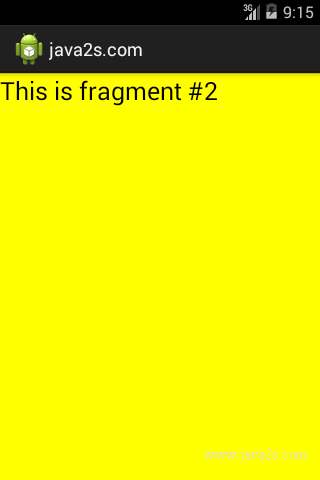Android UI How to - Add Fragments Dynamically
The following code shows how fragments can be added programmatically to an activity during runtime.
Example
Modify the activity_main.xml file as follows:
<?xml version="1.0" encoding="utf-8"?> <LinearLayout xmlns:android="http://schemas.android.com/apk/res/android" android:layout_width="fill_parent" android:layout_height="fill_parent" android:orientation="horizontal" > </LinearLayout>
In the res/layout folder, add a new file and name it fragment1.xml.
Populate it with the following:
<?xml version="1.0" encoding="utf-8"?>
<LinearLayout/*from w ww .ja v a 2 s. c o m*/
xmlns:android="http://schemas.android.com/apk/res/android"
android:orientation="vertical"
android:layout_width="fill_parent"
android:layout_height="fill_parent"
android:background="#00FF00"
>
<TextView
android:layout_width="fill_parent"
android:layout_height="wrap_content"
android:text="This is fragment #1"
android:textColor="#000000"
android:textSize="25sp" />
</LinearLayout>
Also in the res/layout folder, add another new file and name it fragment2.xml.
Populate it as follows:
<?xml version="1.0" encoding="utf-8"?>
<LinearLayout// w w w .jav a 2s.co m
xmlns:android="http://schemas.android.com/apk/res/android"
android:orientation="vertical"
android:layout_width="fill_parent"
android:layout_height="fill_parent"
android:background="#FFFE00"
>
<TextView
android:layout_width="fill_parent"
android:layout_height="wrap_content"
android:text="This is fragment #2"
android:textColor="#000000"
android:textSize="25sp" />
</LinearLayout>
Under the com.java2s.Fragments package name, add two
Java class files and name them Fragment1.java and Fragment2.java
Add the following code to Fragment1.java:
package com.java2s.myapplication3.app; /*from w ww . j a v a2s .c o m*/ import android.app.Fragment; import android.os.Bundle; import android.view.LayoutInflater; import android.view.View; import android.view.ViewGroup; public class Fragment1 extends Fragment { @Override public View onCreateView(LayoutInflater inflater, ViewGroup container, Bundle savedInstanceState) { //Inflate the layout for this fragment return inflater.inflate(R.layout.fragment1, container, false); } }
Add the following code to Fragment2.java:
package com.java2s.myapplication3.app; //from ww w .j a v a2 s.co m import android.app.Fragment; import android.os.Bundle; import android.view.LayoutInflater; import android.view.View; import android.view.ViewGroup; public class Fragment2 extends Fragment { @Override public View onCreateView(LayoutInflater inflater, ViewGroup container, Bundle savedInstanceState) { //Inflate the layout for this fragment return inflater.inflate( R.layout.fragment2, container, false); } }
Add the following code to the MainActivity.java file:
package com.java2s.myapplication3.app; import android.app.Activity; import android.app.FragmentManager; import android.app.FragmentTransaction; import android.os.Bundle; import android.view.Display; import android.view.WindowManager; //from w ww . ja v a2 s . co m public class MainActivity extends Activity { @Override public void onCreate(Bundle savedInstanceState) { super.onCreate(savedInstanceState); FragmentManager fragmentManager = getFragmentManager(); FragmentTransaction fragmentTransaction = fragmentManager.beginTransaction(); //get the current display info WindowManager wm = getWindowManager(); Display d = wm.getDefaultDisplay(); if (d.getWidth() > d.getHeight()) { //landscape mode Fragment1 fragment1 = new Fragment1(); // android.R.id.content refers to the content // view of the activity fragmentTransaction.replace( android.R.id.content, fragment1); } else { //portrait mode Fragment2 fragment2 = new Fragment2(); fragmentTransaction.replace( android.R.id.content, fragment2); } fragmentTransaction.commit(); } }

Note
Run the application on the Android emulator. Observe changes when switch from portrait mode to landscape mode.